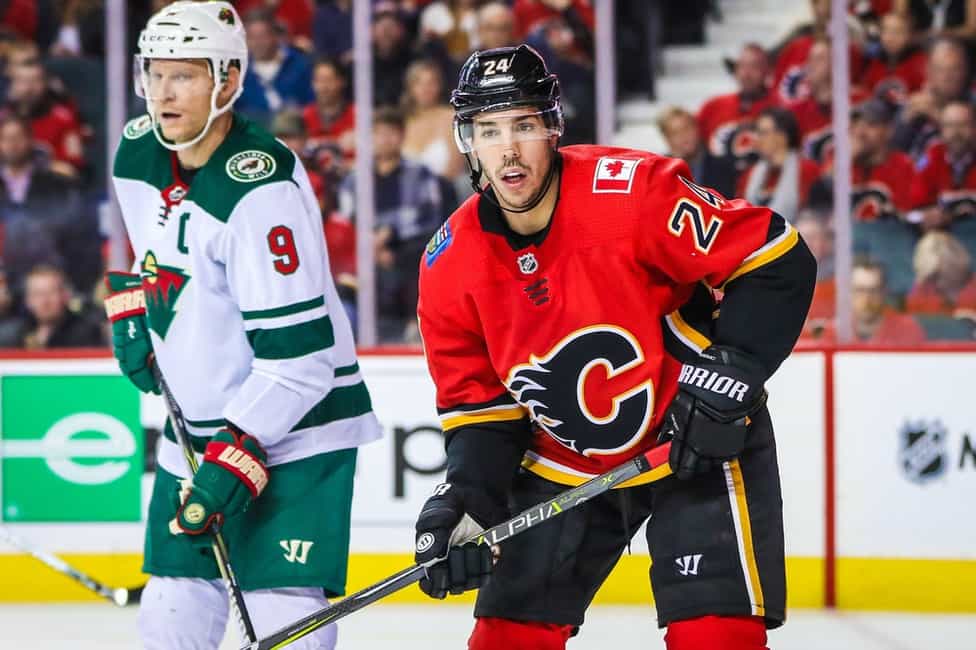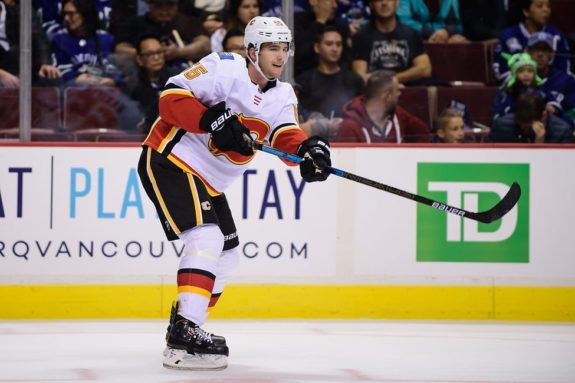
When Brad Treliving became general manager of the Calgary Flames in the spring of 2014, he inherited a team that had just finished near the National Hockey League’s basement. Through some savvy trades and maneuvering, he managed to slowly but surely transform the hockey club.
Travis Hamonic’s chemistry with Noah Hanifin on the Calgary Flames’ blue line has been a big boon to the club’s defensive balance. (Sergei Belski-USA TODAY Sports)
The Flames’ blue line, in particular, has gotten a big makeover since Treliving arrived. Three trades in particular were key to overhauling the team’s defensive group and providing a lot more skill, depth and poise on the back end.
Treliving’s Starting Seven
When Treliving joined the Flames following the completion of the 2013-14 season, he inherited a group of seven defensemen that had some warts. The first pairing consisted of captain Mark Giordano and speedy TJ Brodie, and was considered a rock-solid pairing with some untapped offensive upside. The remaining five bodies were the rugged Kris Russell, power play specialist Dennis Wideman, and depth bodies Ladislav Smid, Chris Butler and Shane O’Brien.
#Flames/Treliving buyouts:
-Shane O’Brien
-Mason Raymond
-Lance Bouma
-Ryan Murphy
-Troy Brouwer— Ryan Pike (@RyanNPike) August 3, 2018
Treliving’s first few moves involved tinkering around the fringes of his lineup. He bought out O’Brien and let Butler walk as an unrestricted free agent. To fill those spots the Flames signed Deryk Engelland during the annual free agent frenzy, then added Raphael Diaz after a training camp tryout. Smid was transitioned to a supporting role due to injuries.
As a result of the changes, the 2014-15 Flames ran with three primary pairings: Giordano and Brodie, Russell and Wideman, and Diaz and Engelland. The group was good enough to make the playoffs, but were too reliant on the top pairing to be effective down the stretch.
2015 NHL Draft: The Dougie Hamilton Trade
As a result of swapping Sven Baertschi and Curtis Glencross prior to the 2015 trade deadline, the Flames went into the 2015 NHL Draft with some extra picks to work with. Treliving turned a lot of heads when he packaged a first round pick and two second round selections to the Boston Bruins for Dougie Hamilton.
Big, rangy and offensively-oriented, the idea behind the swap was that the Flames relied too much on the Giordano/Brodie pair. Adding Hamilton would, in theory, allow them to change their pairings a bit and potentially formulate a formidable top four grouping. The third pairing might not put fear into the hearts of their opponents, but in the other 45-to-50 minutes of the game the Flames’ other pairs would be able to dictate the game.
It didn’t quite work out that way, though. After initially trying Hamilton with Russell, to very mixed results, Hamilton was moved to play with Giordano and Russell was paired with Brodie. That top four configuration was a bit better, but also didn’t really click as intended. With the Flames languishing near the bottom of the standings, the Flames hedged their bets and shipped Russell (a pending free agent) to the Dallas Stars.
2017 NHL Draft: The Travis Hamonic Trade
The 2016-17 Flames were very close to their previous counterparts, except with Finnish blueliner Jyrki Jokipakka swapped in for Russell. The primary pairings were Giordano and Hamilton, Brodie and Wideman, and some combination of Engelland, Jokipakka and trade deadline addition Michael Stone. The defensive group was fairly good, but not quite deep enough to compete in the post-season.
[embedded content]
Seeking a bit more physicality, maturity and depth on the back end, Treliving made another draft weekend swap. At the 2017 NHL Draft he sent a first round pick and two second round selections to the New York Islanders in exchange for Travis Hamonic and a fourth round pick. Wideman subsequently left the club as a free agent in the same off-season.
The addition of Hamonic once again was aimed at giving the Flames two strong top pairings for 2017-18, this time with Hamonic being slotted alongside Brodie while Giordano and Hamilton were kept together as a pair. The third pairing was Stone with rookie Brett Kulak. Stone and Kulak were a solid depth pairing, but Brodie and Hamonic struggled to find a stylistic fit while Giordano and Hamilton put up strong offensive numbers but had uneven results in their own end.
2018 NHL Draft: The Noah Hanifin Trade
On the heels of missing the post-season for the second time in three seasons, Treliving went back to the drawing board at the 2018 NHL Draft and made another significant swap. Rather than add to his big-name blueliners, he decided to change its composition. He swapped Hamilton, forward Micheal Ferland and prospect Adam Fox to the Carolina Hurricanes in exchange for Noah Hanifin and Elias Lindholm.

Signed through 2023-24, Noah Hanifin is expected to be a foundational piece on the Flames blue line. (Anne-Marie Sorvin-USA TODAY Sports)
The motivation behind the move seemed two-fold: the left-shooting Hanifin gives the Flames options (along with prospect Juuso Valimaki) in a long-term succession plan for the 35-year-old Giordano. But moreso, the move seemed motivated to provide added balance and stylistic fit across the pairings.
Brodie was returned to the top pairing with Giordano and immediately rekindled their old chemistry, while the physical Hamonic was put with the speedy Hanifin in a nicely balanced second group. While Valimaki began the season on the third pairing with Stone, a combination of injuries and some strong play early on has seen that pairing revert to a pair of rookies: 2015 picks Oliver Kylington and Rasmus Andersson.
Additional Skill, Additional Depth
Not many hockey clubs can afford to put rookies on the same pairing; they’re inexperienced and are prone to lapses, which means they typically need to be given favourable match-ups and linemates. But the Flames have dramatically improved the balance and skill level of their top two defensive pairings by way of Treliving’s swaps, which has allowed him to transition two players that were drafted a year after he arrived into the NHL in relatively short order. The Flames have a much better blue line group than they did when their GM arrived in 2014, but their ability to incorporate a pair of rookies and give them space to adjust to the NHL has given them three pairings that can play with speed, skill and poise – something they sorely lacked back in 2014.
Be the first to comment